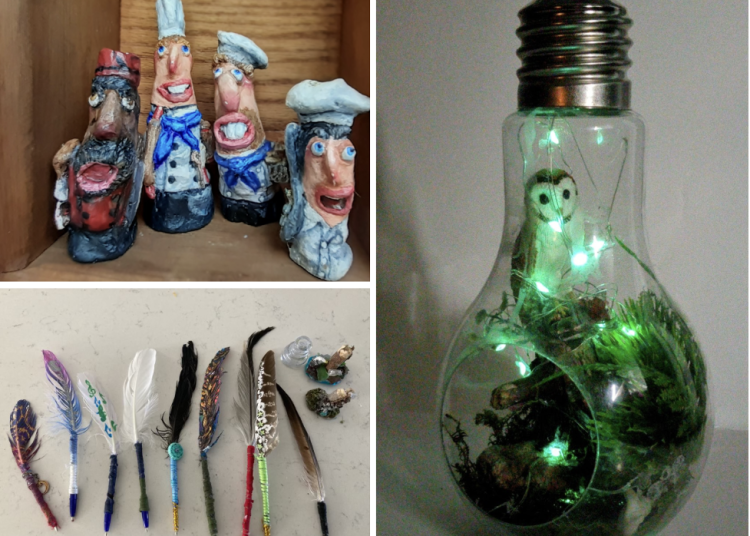“Be nice. Be kind. Don’t look at us like we’re a piece of dirt. We don’t mean any harm,” says John Gilmour, an artist who has been homeless three times in the last year. “If you fall, we’ll be there to help you. If you need help – for us to carry your groceries – we’ll help you. We don’t want anything. We just want respect.”
Gilmour, who arrived in Fredericton five years ago, describes the homeless community as “people like all of us” who are just trying to get by. They hope for friendship, compassion, and small acts of kindness.
“We don’t always want money. We just want friends,” says Gilmour. “We might just need a ride to the doctor’s or a shoulder to cry on. I know there are some bad people out there, but we’re not all bad. Sometimes we just need someone to help out.”
A 2024 “point in time” study by the Human Development Council reported that 181 people were experiencing homelessness in Fredericton on November 24, 2024; this included people living in encampments, shelters, transitional housing, and those who were couch-surfing.
Weakened by heart problems and shaky knees, Gilmour has fallen in the streets numerous times; he merely wishes people might offer to help him to his feet.
“Don’t be afraid to help people out on the street who have fallen down,” says Gilmour. “Empathy. Just think – if it were your daughter or your son out there, dealing with this, and they’re out there alone.

For Gilmour, the stigma around homelessness also exists in some organizations that intend to help. They might address some immediate stresses of homelessness – such as shelter and food – but fall short of helping community members transition to a stable life. Long-term, this can sustain homelessness rather than structurally empower community members to better their lives.
“It’s not very nice when you’re homeless, because they don’t try to help you get out. They just want you to sit there and they want to avoid it.”
This sentiment was echoed in a city-funded 2021 report titled “Fredericton Housing Needs Assessment”: “While attention has been focused on the issue of homelessness itself, other critical elements of the system required to help shift individuals and households into stable, long-term living situations have not received the same consideration. Transitional and Supportive housing is necessary to fill this gap, and is currently a bottle neck that helps to perpetuate homelessness and housing insecurity.”
Transitional housing is a temporary measure for those experiencing intermittent homelessness, such as people escaping their homes due to domestic violence. Supportive housing is a more long-term measure for those who experience chronic homelessness, which may arise from mental illness, disabilities, and substance use. In Fredericton, some transition houses and supportive housing units are managed by Fredericton Homeless Shelters and the John Howard Society of Fredericton, respectively.
Gilmour shares that struggles with homelessness are exacerbated for people who have mental illnesses. Treatments are costly and doctors can be dismissive. Diagnosed with schizophrenia and bipolar disorder at twenty-eight years of age, Gilmour says his medications can cost thousands of dollars a month. Meanwhile, some doctors don’t acknowledge the suffering that comes with taking medications.
“I know more about the medication than they do. I know all the side effects. They don’t listen. I’m going through it – it’s anxiety, it’s depression. They don’t listen. They don’t take the time to listen.”
If his states of psychosis last too long, his rent payments can be missed and give way, again, to homelessness.
A 2021 report by Fredericton physician Sara Davidson, published in the Journal of New Brunswick Studies, states that “no suitable housing exists for these people (who)…live with complex substance use and mental health disorders and struggle to conform to conditions required in shelters or housing.” Davidson favours “Housing First” solutions in which housing is not conditional on overcoming long-standing issues, like sobriety. This is in contrast to “treatment before housing” approaches that deem people unfit for housing until such issues are resolved.
“It is not realistic to expect people to resolve long-standing mental health and substance use issues without the fundamental security of housing,” Davidson writes.
Gilmour says local churches and the organization Under the Tent – which offers food, clothing, and other support to people experiencing homelessness – helped him find his feet. For a month, they paid for him and his wife to stay in a motel. He kept creating artwork – antiques, rings, and keychains – that were soon embraced by local businesses. The Artisan’s District, U Beautiful Creature, and Isaac’s Way Restaurant carry his art.
“I appreciate these people who took care of us and helped us. The churches, businesses,” says Gilmour. “There are a lot of good people in Fredericton. A lot. And all of a sudden, I have my own shelves in there.”
Now, Gilmour strives to inspire others to follow their dreams. He donates some of his proceeds to local services, like Capital Region Mental Health and Addictions.
“I’m following my dream,” says Gilmour. “Now I want them to follow their dreams. I want to keep inspiring. I want to inspire people to go on. I want everyone to know – don’t give up. If you have a dream, don’t give up.”
***

Gilmour’s art is versatile. He paints, sculpts, refashions antiques, makes jewelry; arranges spiraling lights into glass bottles and fills them with miniature nature scapes; crafts quaint quills from feathers, leather, and old ballpoints; seeks inspiration from long nature walks where he picks up moss, rocks, feathers, twigs, flowers, and more to sanitize and turn into new art pieces.
His art is largely driven by states of psychosis. When his medications wear off, he “gets shocks all the way through” his body. The ensuing psychosis oscillates from hyper-productive mania to paranoid rage to hallucinations.
“When it is in my head, I can’t stop (my art). I can’t stop midway. If it’s not finished in one or two days, I’m up for one or two days,” he says. “When I’m in a schizophrenic state, I’m angry all the time. It’s like there’s a monster inside me, I don’t like anybody. It’s hard. I really wish I wasn’t like this, but I can’t help it. Sometimes I’m really angry and I break some of my stuff, or I try to destroy the equipment. I don’t remember, sometimes, what happens. I don’t know what’s real or not. Sometimes, for two weeks, I’m not eating, I’m not drinking. I don’t trust anything. I trust my wife, she’s the only one I trust.”
Gilmour’s artistic process maps his states. He flocks to art for self-expression when his feelings elude him. He describes some of his creations: a decorated skull, a recrafted broken jewelry box, a nature scape in a lit up music box, leather-bound quills, and sculptures of chefs.

One of Gilmour’s large wooden music boxes opens to a whimsical scenery of miniature polymer clay crows and skunks frolicking near a winding pine tree. Fairy lights are studded in the back of the box; a small button on the side illuminates the nature scape in a blue glow. The lid is padded with a home-made screen heavy with artfully glued moss, twigs, and feathers. Gilmour buys the wood boxes at Michael’s, glues the internal circuitry of a music box to the back, and fashions the decorations within using a scalpel, scissors, a glue gun, and his oven for the clay creations.
“I don’t have tools in my house. I use my hands. I just use screwdrivers, scissors, knives, stuff like that,” says Gilmour, sharing that he taught himself how to carve with a knife. “The first time (I carved), my hands were cut up so bad, it wasn’t even funny. I had to stop, then went back at it.”
His quills, complete with handcrafted stands, use real feathers that Gilmour finds on nature hikes. The stem of each feather is resourcefully bound with ribbons of soft leather to the thin plastic tubes inside ballpoint pens. Gilmour paints some of the feathers with patterns, like music notes or silver moons, or places small charms and sequins that accentuate the feather’s natural movement. He sanitizes the feather, covers it in a seal, paints it, and adds the seal again. The quills perch in wooden stands carved with a screwdriver and adorned with moss to mimic the base of a tree. The quills are thin, soft, vary in length, and write smoothly.
“It’s not easy,” Gilmour says of the process. “You have to follow the fissures of the feather, otherwise it doesn’t solidify well.”
Once, when Gilmour was in a state of psychosis, he broke the glass of his wife’s jewelry box. A month and a half later, he placed cardboard over the broken glass as a canvas, glued on a sweeping arrangement of rings, buttons, keys, flowers, wood, rocks, and metallic charms, and drew “some characters and some faces of different emotions” reminiscent of the psychosis. Affectionate messages to his wife were painted in blue at the edges of the box; a longer letter was written on the surface inside.
“There are messages on her jewelry box… on things that we know to each other and not too many people know.”
Before Gilmour was an artist, he worked as a chef. He artistically commemorates some of the chefs he knew with eccentric, hand-moulded clay chefs that convey their “grumpy, happy characters.” The chefs have aprons, white hats, caricatured eyes, and exaggerated moody looks. Each takes about two pounds of clay and forty-eight hours to sculpt. Once the figurines are done, he places them in the oven to bake, sands them, bakes them again, covers them in a sealant, and bakes them for a third time. The full process takes two weeks. He sold over 200 chefs in the last year at The Artisan District, Under the Tent, and U Beautiful Creature.

“I didn’t think they would ever sell. I have some loyal customers who have followed me everywhere,” says Gilmour, noting Under The Tent’s appreciation. “I’m thankful for them, they love my art. They bought feather pens, the chefs. One bought so many chefs she brought a carrying case for them. They buy my necklaces, my rings.”
Gilmour especially cherishes his wife for her constant support – in art, and in life. He tells her when his states are coming, that he won’t “be here, be himself” for a week or two, and asks that she “please bear with (him)”. She is patient, understanding, and resolute.
“My wife is the best support I could ever ask for. My wife – she is quiet, timid, like a mouse. But when she roars, she’s a lion,” says Gilmour. “She’s my partner not just in love and marriage, she’s my partner in everything. She’s there when I’m down, she’s there when I’m up. And when she’s down – she has mental illness herself – I’m there for her.”
John Gilmour previously discussed his drawings of schizophrenic hallucinations and his mental health advocacy for the November 2023 article: “I would like them to wonder”: Drawings of schizophrenia
Incé Husain is a neuroscience graduate student and journalist who writes for the NB Media Co-op and Antler River Media Co-op. She pursues local stories independently at The Unprecedented Times. She is based in London, Ontario.
A version of this article was first published by the The Unprecedented Times on August 11, 2025.









